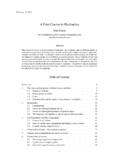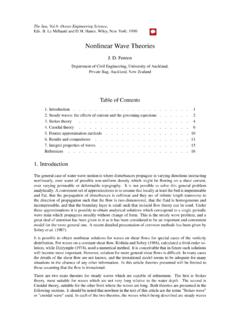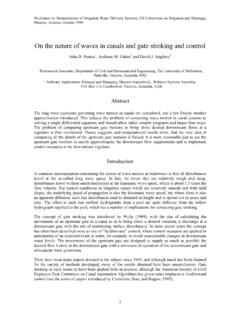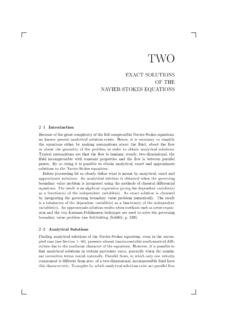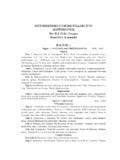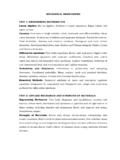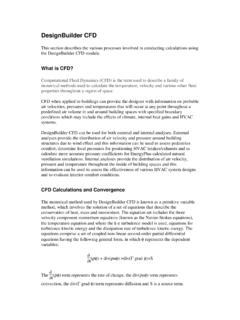Transcription of j ' 'A, FIFTH-ORDER STOKES THEORY ,, FOR STEADY WAVES …
1 ( j ' 'A, FIFTH-ORDER STOKES THEORY . ,, ' ~ ' FOR STEADY WAVES By John D. Fenton' ABSTRACT: An alternative STOKES THEORY for STEADY WAVES in water of constant depth is presented where the expansion parameter is the wave steepness itself. The first step in application requires the solution of one nonlinear equation, rather than two or three simultaneously as has been previously necessary, In addition to the usually specified design parameters of wave height, period and ~ water depth, it is also necessary to specify the current or mass flux to apply any STEADY wave THEORY . The reason being that the WAVES almost always travel on some finite current and the apparent wave period is actually a Doppler-shifted period. Most previous theories have ignored this, and their application has been indefinite, if not wrong, at first order . A numerical method for testing theoretical results is proposed, which shows that two existing theories are wrong at fifth order , while the present THEORY and that of Chappelear are correct.)
2 Com-parisons with experiments and accurate numerical results show that the present THEORY is accurate for wavelengths shorter than ten times the water depth. INTRODUCTION The problem of a steadily-progressing periodic wave train is perhaps the simplest problem in the field of water WAVES , and yet because of the nonlinear nature of the governing equations, has been solved accurately only in recent years, during which several interesting phenomena have been discovered. For a recent survey of the problem and various solu-tions, reference can be made to Schwartz and Fenton (10). For practical problems, an application-oriented accurate method is that of Rienecker and Fenton (8), however this and all others which obtain accurate so-lutions even for high WAVES are based on numerical methods, and are not presented as explicit solutions. In problems where the WAVES are not very high or where great accuracy is not required, it is more reasonable to use an approximate explicit solution, such as cnoidal THEORY for shal-low water or STOKES ' THEORY for deeper water.
3 The essential features of STOKES ' THEORY for periodic STEADY WAVES are: .all variation in the direction of propagation is represented by Fourier series, and the coefficients in these series can be written as perturbation expansions in terms of a parameter which increases with wave height. STOKES used ak, the leading term in a Fourier series, in which k = the wave number, k = 27r/A; and A =the wavelength, and a has no physical significance other than that of being a length scale which is equal to the amplitude of the wave at lowest order . The terms in the perturbation expansion can be found by satisfying boundary conditions on the free surface, and solving the resulting set of ordered equations. The shortest way of proceeding to a solution is by an inverse method, in which the complex coordinate in the physical plane is obtained as a 1Sr. Leet., School of Mathematics, Univ.
4 Of New South Wales, Kensington, , Australia 2033. open until August 1, 1985. To extend the closing date one month, a written request must be filed with the ASCE Manager of Journals. The manuscript for this paper was submitted for review and possible publication on March 18, 1983. This paper is part of the Journal of Watenvay, Port, Coastal and Ocean Engineering, Vol. 111, No. 2, March, 1985. ASCE, ISSN 0733-950X/ 85/0002-0216/$ Paper No. 19605. 216 function of the complex velocity potential. In this case the boundaries of the problem are known initially, as the stream function is constant on the bottom and on the free surface. For arbitrary constant depth, STOKES obtained a solution to third order in ak. This was taken to fifth order by De (4). Subsequently, computer manipulation of the series was used by Schwartz (9) and Cokelet (2) to obtain numerical values of the coefficients for a given ratio of depth to wavelength to very high orders.
5 Schwartz found that use of the leading coefficient, ak, as the expansion parameter had an important limitation. ak reaches a maximum before the highest wave is attained, with the result that convergence of the series is limited. This was partially overcome by using the actual crest-to-trough wave height, H, in the expansion parameter, as kH/2, but it was necessary to use convergence-enhancement procedures to obtain ac-curate results for steep WAVES . For the solution of many practical problems, the inverse plane results are not readily applicable. De (4) reverted his series to give an expression for the complex potential, from which velocities can be obtained as a function of position. Similar FIFTH-ORDER results were presented by Chap-pelear (1), who suggested that De's results were wrong at fifth order . For practical application, however, this approach has a limitation in that the THEORY is presented in terms of ak and kl, in which l = a depth scale given by the ratio of the volume flux under the stationary WAVES to the mean fluid velocity on a constant level.
6 It is not, in general, equal to the depth, and is initially unknown. This causes difficulty in practical prob-lems as neither a nor I, and usually not k, are known a priori. They have to be obtained through the solution of three simultaneous nonlinear equations. It is difficult to obtain a solution to these equations in the limit of shallow water and, surprisingly, also in the deep water limit. An approximate procedure for the latter case has been given by Dailey (3). Skjelbreia and Hendrickson (11) obtained an alternative FIFTH-ORDER STOKES THEORY , proceeding via the physical plane. They obtained a so-lution in terms of ak and kd, in which d = the mean fluid depth. Their THEORY is slightly simpler to apply than those obtained via the inverse plane, for only two nonlinear simultaneous equations have to be solved for a and k. However, obtaining a solution is still often difficult.
7 It will be shown in the following that the Skjelbreia and Hendrickson THEORY is, in fact, wrong at fifth order . All of the theories described previously have made the implicit as-sumption that the WAVES travel at STOKES ' first definition of wave speed. As a result, in the frame of interest, they travel such that the time mean-fluid velocity at all points within the fluid is zero. This need not be the case, of course. Indeed, it is much more likely that the WAVES are trav-elling on some small but finite current, whether it be positive or nega-tive, and the measured period is a Doppler-shifted period. The theories do not determine the wave speed-it is determined by external physical factors, such as the current, or, in other situations, by the mass or vol-ume flux underneath the WAVES . Tsuchiya' and Yamaguchi (12) have de-veloped a fourth- order THEORY in which it is assumed that the WAVES travel at STOKES ' second definition of wave speed, such that the mass flux is zero.
8 While this is the case for experiments in a closed tank, in 217 general it need not be true either. In the general case, to apply any STEADY wave THEORY it is usually necessary to know either the wave speed or the current or the mass flux. This has been pointed out by Rienecker and Fenton (8), and allowed for in their numerical method. In this paper a FIFTH-ORDER STOKES THEORY for STEADY WAVES is presented in which an attempt is made to correct and to obviate some of the dis-advantages of previous theories. Instead of an unknown Fourier coef-ficient ak being used as expansion parameter, the dimensionless wave height (wave steepness) is used in the form kH/2. The expressions for the individual coefficients are functions only of the dimensionless depth, kd, so that the only unknown, ab initio, is the wave number k, which can be found by the numerical solution of a single nonlinear equation.
9 Two alternative possibilities for this equation are given, one in terms of the mean current at a point, the other in terms of the mean mass (vol-ume) flux under the WAVES . If neither of these quantities is known, nor any other factor which determines the wave speed, then there is little point in using the FIFTH-ORDER THEORY or any other high- order THEORY . The results would be mathematically inconsistent at first order , and inclusion of higher order terms simply a waste of time. The present solution and two previous FIFTH-ORDER solutions are checked numerically, and it is shown that both De's and Skjelbreia and Hen-drickson's theories are wrong at fifth order . Subsequently, application of the THEORY to practical problems is examined, showing when and how the present THEORY can be used. Finally, results from the present THEORY are compared with some experimental data, and with accurate results from numerical solutions.
10 STEADY WAVE EQUATIONS AND THEIR SOLUTION The problem considered is that of periodic WAVES propagating without change of form over a layer of fluid on a horizontal impermeable bed. The origin is on the bed, the horizontal coordinate is x and the vertical coordinate is y. This reference frame moves with the same velocity as the WAVES so that in this frame all motion is STEADY . The problem can be uniquely solved in this frame. Not until any other frame of reference c 1 -.. A .. I'-~ J__=--~ :i--i---c----i Vt X d yt ~ x r 1 I I , I i I ; / i ' I I ' / I I l l I I I / Tl / I I I I I I I I I I ; I I I I I f----ct~__j FIG. Wave of STEADY Periodic Wave Train, Showing Important Physical Quantities 218 is considered does the wave speed have to be known. Fig. 1 shows the physical situation and important dimensions. If the fluid is incompressible, a stream function, ljl, exists such that velocity components (u,v) are given by u = alji/ay, v = -alji/ax, and, if the motion is irrotational, ljJ satisfies Laplace's equation throughout the fluid.

